
Churches - Bevendean History Project

St Margaret's Church, Cannon PlaceSt Margaret’s formally in Cannon Place Brighton, was a church which was demolished in 1959 to make way for Sussex Heights.
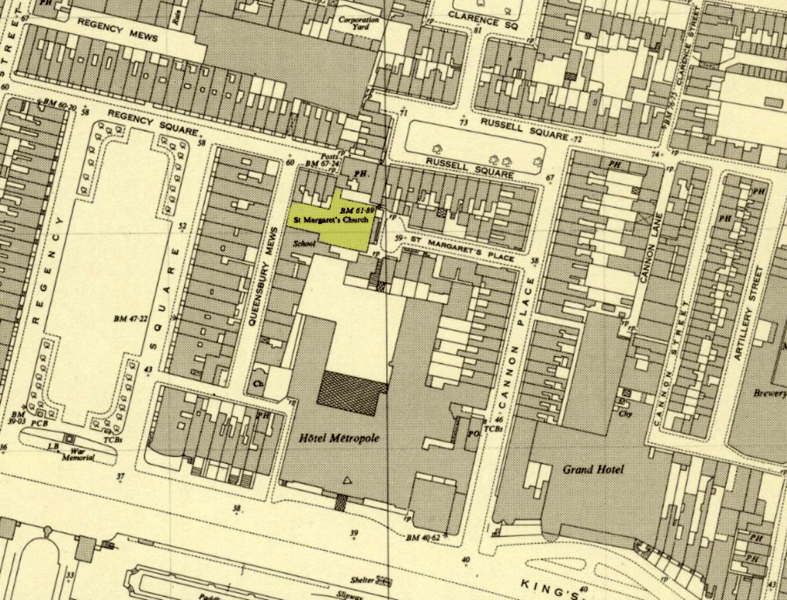
The location of St Margaret’s Church was at the end of St Margarets Place, which leads off Cannon Place.
This Chapel was designed by Charles Busby with the first stone being laid on May 24th, 1824. The building was carried on with such rapidity that the Church was opened for worship on December 26th, 1824. The building was commissioned by Barnard Gregory, the editor of the 'Brighton Gazette' and the dedication to St Margaret was after the editor’s wife, Margaret. Alterations were made by Amon Wilds in 1830 and the building was further enlarged in 1874. The Church was hidden away behind the Hotel Metropole and the houses of Regency Square and Cannon Place and was a striking building with an Ionic front, with four massive columns. It stretched across the west end of St. Margaret’s Place, blocking what would otherwise have been a thoroughfare.
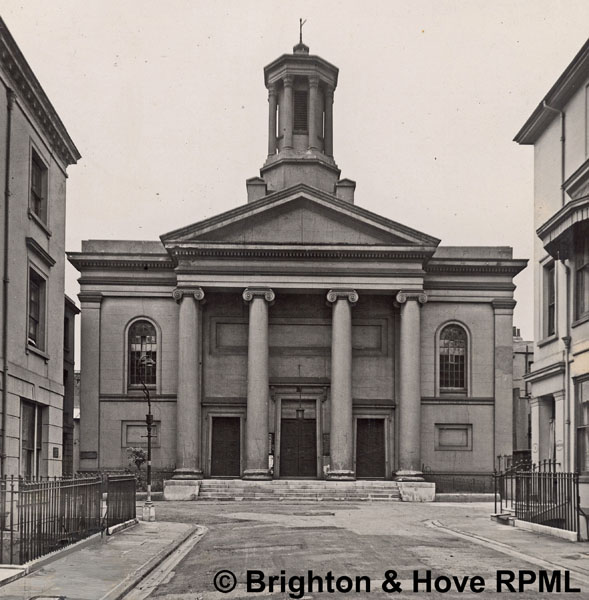
This large Church enjoyed a reputation in Brighton, and beyond the town and county, for the distinctively Evangelical character of its services, the extreme liberality of its large congregation to all kinds of good works, its varied and useful services to the town, and its zeal for the cause of Foreign Missions.
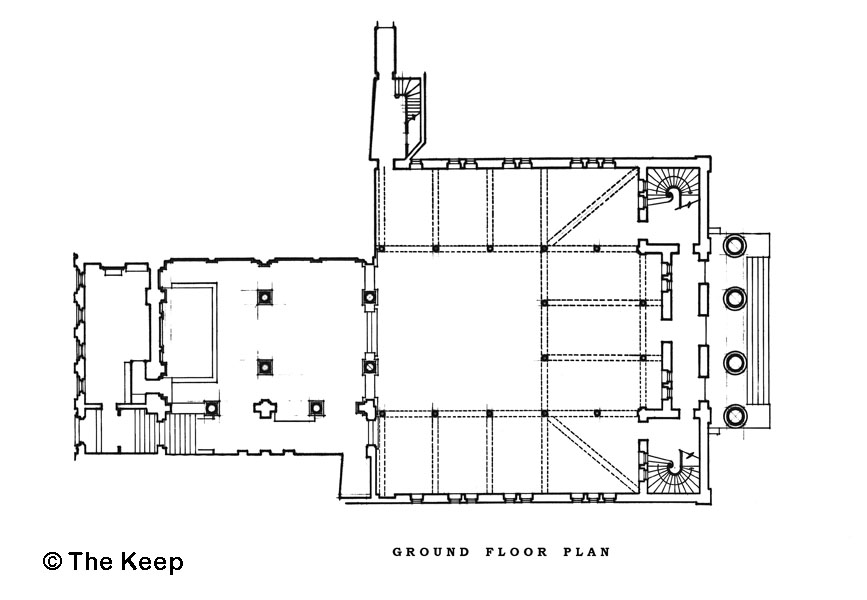
St. Margaret’s was erected under a special Act of Parliament, and the fabric of the Church, which was for over forty years the property of Miss E. E. Hornbuckle, passed at her death in 1914 into the hands of a body of Evangelical trustees. The patronage was in the hands of the Vicar of Brighton, and the Church had a conventional district assigned to it. There were 1,460 seats in the Chapel for the congregation.
In 1874 the whole structure was greatly enhanced by the addition of a very imposing and lofty chancel by Mr. J. O. Scott (son of Sir Gilbert Scott). The interior was rich and spacious with a chancel 41ft. long, 30ft. wide and 45ft. high. It was supported by a large chancel arch, with a smaller arch on either side. A similar arcade of three arches was built about mid-way between the first arches and the sanctuary. The six arches rested upon massive pillars of Penryhn stone. Other arches, which separated the south aisle from the chancel rested on pillars of Bath stone.
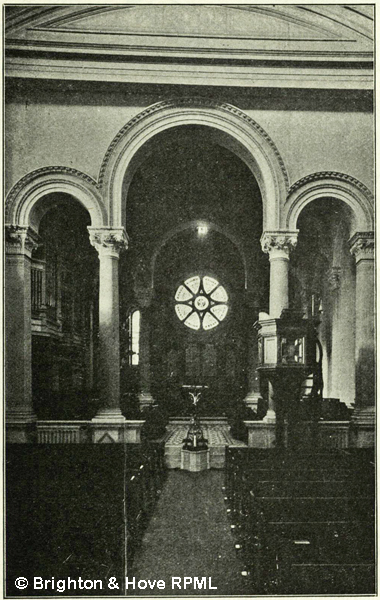
St Margaret's Church interior towards the Sanctuary c1915.
During the incumbency of the Rev. Edmund Clay (1855-1872) the
upper gallery running from north to south was built for the use of the
Brighton fishermen and boatmen, above a memorial tablet recording his
ministry could be seen in a bas-relief in white marble the sea and
sea-shore, and in the waves a fishing boat, an exact representation of
one the Brighton “luggers.” In the foreground on the beach
were heaps of nets and fishing gear.
He was a remarkable man, and the effect of his ministry in Brighton was widespread and permanent. Delicate in health, he exercised a wonderful influence among his people, and especially over the rough boatmen and fishermen of Brighton and Hove, so that he earned the title of “the apostle of the Brighton fishermen.”
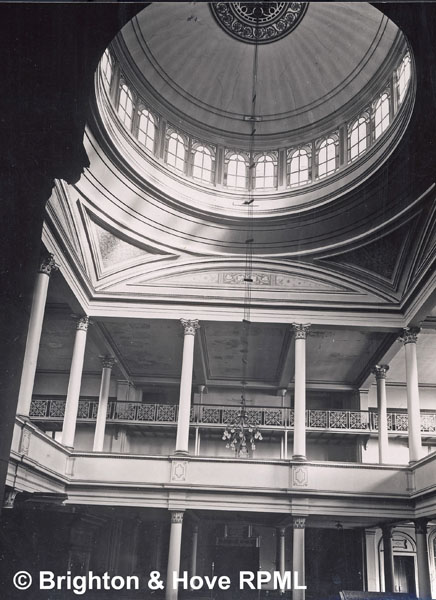
St Margaret’s Church Dome & Galleries 1949.
On his death at the early age of 49, there was a spontaneous and general manifestation of regret and esteem such as the loss of no other Brighton clergyman has ever evoked. At the funeral it is estimated that at least a thousand persons were present. A special train from Brighton conveyed some six hundred friends and members of St. Margaret’s congregation to Hassocks, the funeral taking place at Keymer. The coffin was borne in turn by twelve fishermen, supported by eight pall bearers, members of St. Margaret’s congregation.
During the next seven years the life of the Church was marked by great financial prosperity and some important works were undertaken. The Church was enlarged by the addition of a chancel, costing over £11,000 and the erection of the “Edmund Clay Memorial Schools “at a cost of £2,600, plus a Mission Hall in Cannon Street.
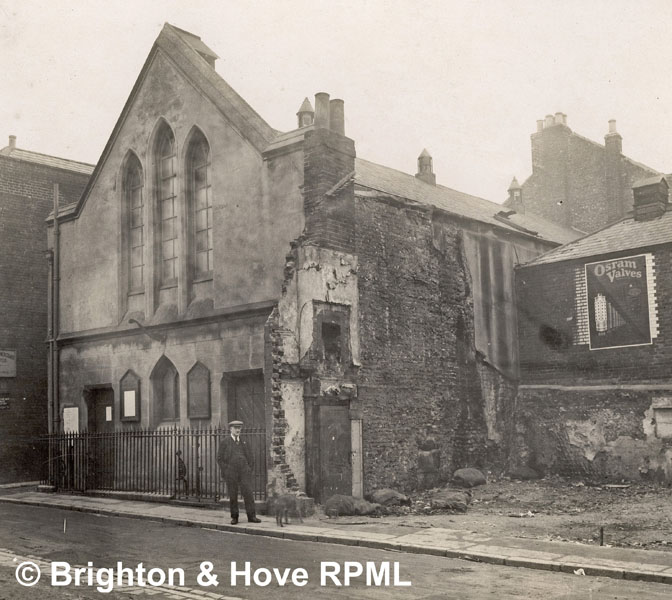
For over twenty years the Church had voluntarily been responsible for a Mission District of 4,000 poor on Carlton Hill in the parish of St. Peter’s, maintaining a staff of workers, and meeting all expenses at a cost of nearly £400 a year. Referring to this contribution to Diocesan work, the following passage occurs in the Annual Report of the Bishop of Chichester’s Fund for 1910: -
“The Parish of St. Margaret’s, Brighton, continues to support the Carlton Hill Mission, and it would be a great satisfaction to the Committee to learn, that the excellent example thus set had been followed by other parishes in a position to provide not only for their own spiritual necessities, but also for those of their poorer brethren in less favoured districts.”
The Cannon Street Mission Hall was the centre of much valuable work, besides affording a home for the Men’s Club with a membership of over 100. The Men’s Bible Class was held each Sunday afternoon.
An important feature in the work at this centre was the Open-air Campaign in the summer months, meetings being held on the lower parade, opposite the Hotel Metropole every Tuesday and Sunday evening.
For over forty years St. Margaret’s maintained a Missioner to the boatmen and fishermen along the 41 miles of sea front in Brighton and Hove. There was an annual charge of some £90 upon the liberal congregation. For the use of these men an arch was provided on the lower parade east of the West Pier, and was found of the greatest value to the fishermen on wet days and in rough weather.
In 1959 the Brighton and Hove Regency Society pleaded for a preservation order to be made for the church, but the Brighton Town Council would not agree to this. The 12.5 cwt bell was removed to the church of Christ the King, South Patcham in January 1959.
In the 1950s Brighton Borough Council investigated converting the St Margaret’s Church in Cannon Place into a museum.
Records held at the East Sussex Record Office includes a report by the Director of the Royal Pavilion Estate, on the proposal and an estimate of the cost of adapting the church for use as a museum of costume.
In the end it was decided that the cost of the conversion could not be justified and the scheme was dropped.
Demolition of St. Margaret’s Church started in June 1959.
St Margaret’s Place still exists today as shown by the photographs below taken in May 2014.
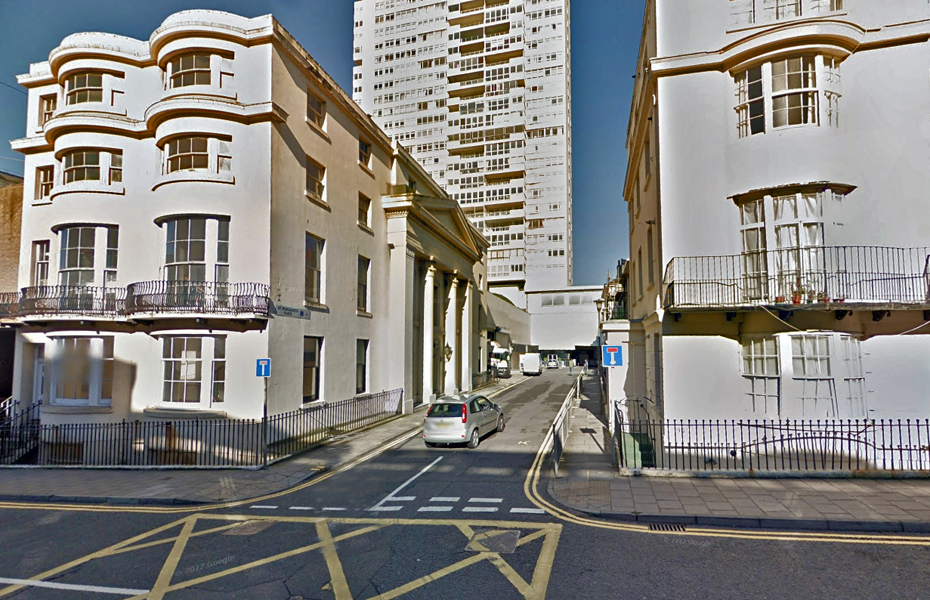
The building on the left was originally the Newburgh Assembly Rooms and residence which adjoined Cannon Place. Built by Amon Henry Wilds c.1833 for Charles Wright, a bookseller and librarian. Only the facade remains today with its Corinthian columns either side of the doorway below a central pediment.
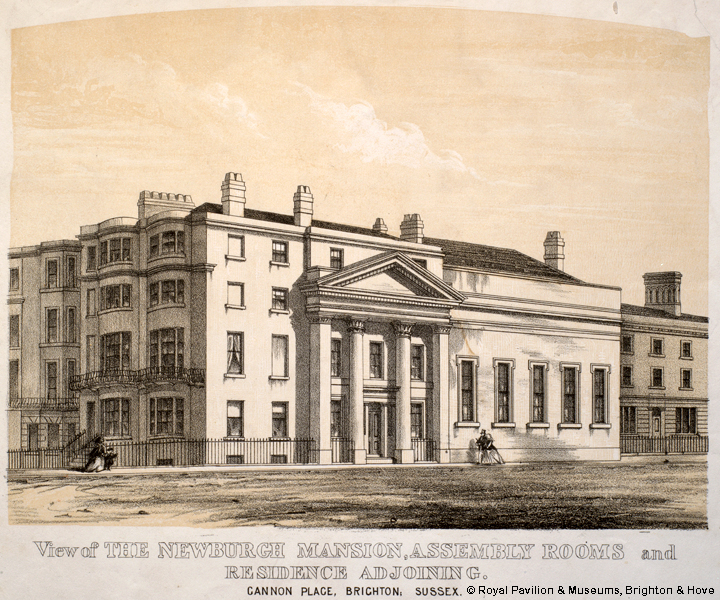
A Tinted lithograph of the Newburgh Mansion from the Brighton and Hove Royal Pavilion and Museum image gallery.
Photographs and plans for St Margaret’s Church

The location of St Margaret’s Church was at the end of St Margarets Place, which leads off Cannon Place.
This Chapel was designed by Charles Busby with the first stone being laid on May 24th, 1824. The building was carried on with such rapidity that the Church was opened for worship on December 26th, 1824. The building was commissioned by Barnard Gregory, the editor of the 'Brighton Gazette' and the dedication to St Margaret was after the editor’s wife, Margaret. Alterations were made by Amon Wilds in 1830 and the building was further enlarged in 1874. The Church was hidden away behind the Hotel Metropole and the houses of Regency Square and Cannon Place and was a striking building with an Ionic front, with four massive columns. It stretched across the west end of St. Margaret’s Place, blocking what would otherwise have been a thoroughfare.

St Margaret's Church at the western end of St Margaret's Place.
This large Church enjoyed a reputation in Brighton, and beyond the town and county, for the distinctively Evangelical character of its services, the extreme liberality of its large congregation to all kinds of good works, its varied and useful services to the town, and its zeal for the cause of Foreign Missions.

Plan of the ground floor of St Margaret’s Church.
St. Margaret’s was erected under a special Act of Parliament, and the fabric of the Church, which was for over forty years the property of Miss E. E. Hornbuckle, passed at her death in 1914 into the hands of a body of Evangelical trustees. The patronage was in the hands of the Vicar of Brighton, and the Church had a conventional district assigned to it. There were 1,460 seats in the Chapel for the congregation.
In 1874 the whole structure was greatly enhanced by the addition of a very imposing and lofty chancel by Mr. J. O. Scott (son of Sir Gilbert Scott). The interior was rich and spacious with a chancel 41ft. long, 30ft. wide and 45ft. high. It was supported by a large chancel arch, with a smaller arch on either side. A similar arcade of three arches was built about mid-way between the first arches and the sanctuary. The six arches rested upon massive pillars of Penryhn stone. Other arches, which separated the south aisle from the chancel rested on pillars of Bath stone.

St Margaret's Church interior towards the Sanctuary c1915.
He was a remarkable man, and the effect of his ministry in Brighton was widespread and permanent. Delicate in health, he exercised a wonderful influence among his people, and especially over the rough boatmen and fishermen of Brighton and Hove, so that he earned the title of “the apostle of the Brighton fishermen.”

St Margaret’s Church Dome & Galleries 1949.
On his death at the early age of 49, there was a spontaneous and general manifestation of regret and esteem such as the loss of no other Brighton clergyman has ever evoked. At the funeral it is estimated that at least a thousand persons were present. A special train from Brighton conveyed some six hundred friends and members of St. Margaret’s congregation to Hassocks, the funeral taking place at Keymer. The coffin was borne in turn by twelve fishermen, supported by eight pall bearers, members of St. Margaret’s congregation.
During the next seven years the life of the Church was marked by great financial prosperity and some important works were undertaken. The Church was enlarged by the addition of a chancel, costing over £11,000 and the erection of the “Edmund Clay Memorial Schools “at a cost of £2,600, plus a Mission Hall in Cannon Street.

Cannon Street Mission Hall in 1935.
For over twenty years the Church had voluntarily been responsible for a Mission District of 4,000 poor on Carlton Hill in the parish of St. Peter’s, maintaining a staff of workers, and meeting all expenses at a cost of nearly £400 a year. Referring to this contribution to Diocesan work, the following passage occurs in the Annual Report of the Bishop of Chichester’s Fund for 1910: -
“The Parish of St. Margaret’s, Brighton, continues to support the Carlton Hill Mission, and it would be a great satisfaction to the Committee to learn, that the excellent example thus set had been followed by other parishes in a position to provide not only for their own spiritual necessities, but also for those of their poorer brethren in less favoured districts.”
The Cannon Street Mission Hall was the centre of much valuable work, besides affording a home for the Men’s Club with a membership of over 100. The Men’s Bible Class was held each Sunday afternoon.
An important feature in the work at this centre was the Open-air Campaign in the summer months, meetings being held on the lower parade, opposite the Hotel Metropole every Tuesday and Sunday evening.
For over forty years St. Margaret’s maintained a Missioner to the boatmen and fishermen along the 41 miles of sea front in Brighton and Hove. There was an annual charge of some £90 upon the liberal congregation. For the use of these men an arch was provided on the lower parade east of the West Pier, and was found of the greatest value to the fishermen on wet days and in rough weather.
In 1959 the Brighton and Hove Regency Society pleaded for a preservation order to be made for the church, but the Brighton Town Council would not agree to this. The 12.5 cwt bell was removed to the church of Christ the King, South Patcham in January 1959.
In the 1950s Brighton Borough Council investigated converting the St Margaret’s Church in Cannon Place into a museum.
Records held at the East Sussex Record Office includes a report by the Director of the Royal Pavilion Estate, on the proposal and an estimate of the cost of adapting the church for use as a museum of costume.
In the end it was decided that the cost of the conversion could not be justified and the scheme was dropped.
Demolition of St. Margaret’s Church started in June 1959.
St Margaret’s Place still exists today as shown by the photographs below taken in May 2014.

Image from Google Street view captured May 2014 © 2024 Google.
The building on the left was originally the Newburgh Assembly Rooms and residence which adjoined Cannon Place. Built by Amon Henry Wilds c.1833 for Charles Wright, a bookseller and librarian. Only the facade remains today with its Corinthian columns either side of the doorway below a central pediment.

A Tinted lithograph of the Newburgh Mansion from the Brighton and Hove Royal Pavilion and Museum image gallery.
Photographs and plans for St Margaret’s Church
